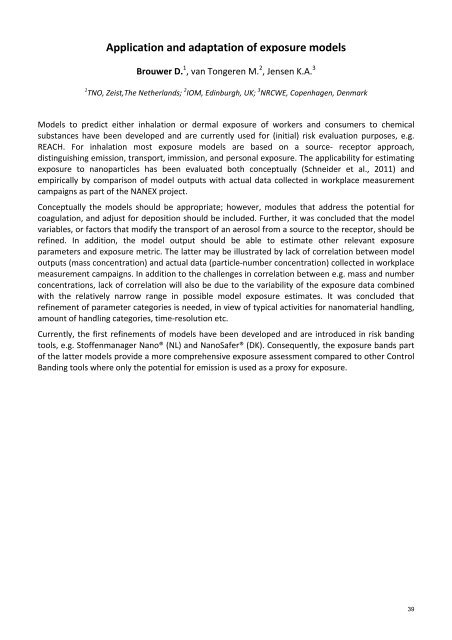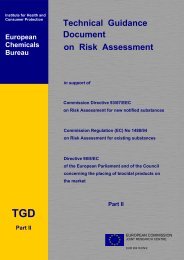Challenges of Regulation and Risk Assessment of Nanomaterials
Challenges of Regulation and Risk Assessment of Nanomaterials
Challenges of Regulation and Risk Assessment of Nanomaterials
You also want an ePaper? Increase the reach of your titles
YUMPU automatically turns print PDFs into web optimized ePapers that Google loves.
Application <strong>and</strong> adaptation <strong>of</strong> exposure models<br />
Brouwer D. 1 , van Tongeren M. 2 , Jensen K.A. 3<br />
1 TNO, Zeist,The Netherl<strong>and</strong>s; 2 IOM, Edinburgh, UK; 3 NRCWE, Copenhagen, Denmark<br />
Models to predict either inhalation or dermal exposure <strong>of</strong> workers <strong>and</strong> consumers to chemical<br />
substances have been developed <strong>and</strong> are currently used for (initial) risk evaluation purposes, e.g.<br />
REACH. For inhalation most exposure models are based on a source- receptor approach,<br />
distinguishing emission, transport, immission, <strong>and</strong> personal exposure. The applicability for estimating<br />
exposure to nanoparticles has been evaluated both conceptually (Schneider et al., 2011) <strong>and</strong><br />
empirically by comparison <strong>of</strong> model outputs with actual data collected in workplace measurement<br />
campaigns as part <strong>of</strong> the NANEX project.<br />
Conceptually the models should be appropriate; however, modules that address the potential for<br />
coagulation, <strong>and</strong> adjust for deposition should be included. Further, it was concluded that the model<br />
variables, or factors that modify the transport <strong>of</strong> an aerosol from a source to the receptor, should be<br />
refined. In addition, the model output should be able to estimate other relevant exposure<br />
parameters <strong>and</strong> exposure metric. The latter may be illustrated by lack <strong>of</strong> correlation between model<br />
outputs (mass concentration) <strong>and</strong> actual data (particle-number concentration) collected in workplace<br />
measurement campaigns. In addition to the challenges in correlation between e.g. mass <strong>and</strong> number<br />
concentrations, lack <strong>of</strong> correlation will also be due to the variability <strong>of</strong> the exposure data combined<br />
with the relatively narrow range in possible model exposure estimates. It was concluded that<br />
refinement <strong>of</strong> parameter categories is needed, in view <strong>of</strong> typical activities for nanomaterial h<strong>and</strong>ling,<br />
amount <strong>of</strong> h<strong>and</strong>ling categories, time-resolution etc.<br />
Currently, the first refinements <strong>of</strong> models have been developed <strong>and</strong> are introduced in risk b<strong>and</strong>ing<br />
tools, e.g. St<strong>of</strong>fenmanager Nano® (NL) <strong>and</strong> NanoSafer® (DK). Consequently, the exposure b<strong>and</strong>s part<br />
<strong>of</strong> the latter models provide a more comprehensive exposure assessment compared to other Control<br />
B<strong>and</strong>ing tools where only the potential for emission is used as a proxy for exposure.<br />
39








